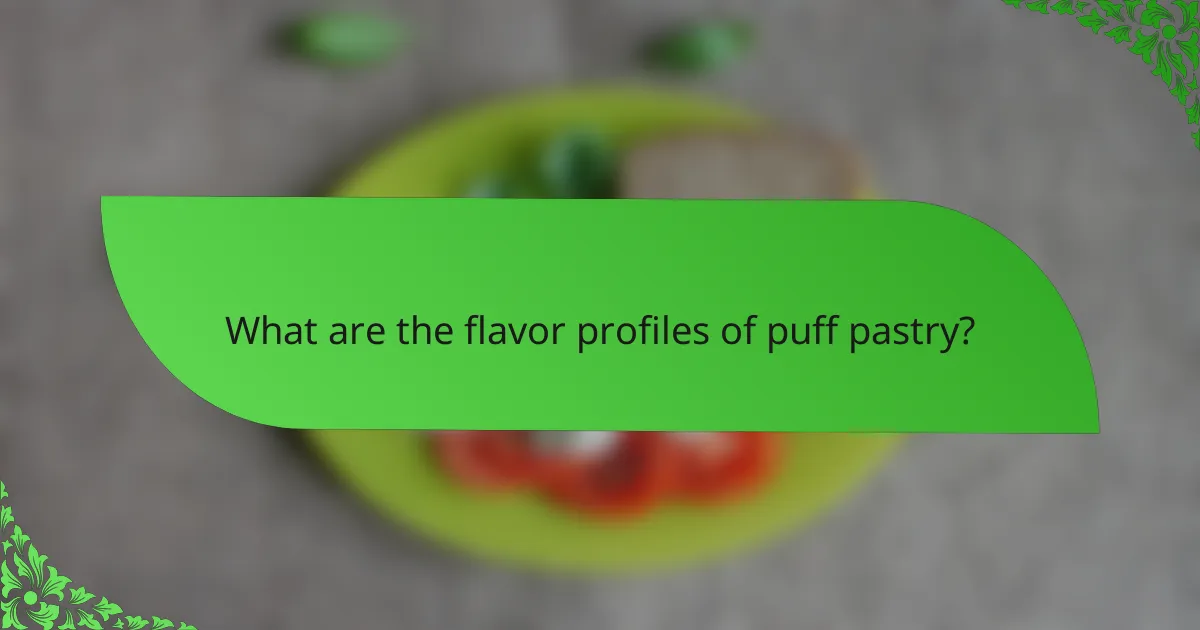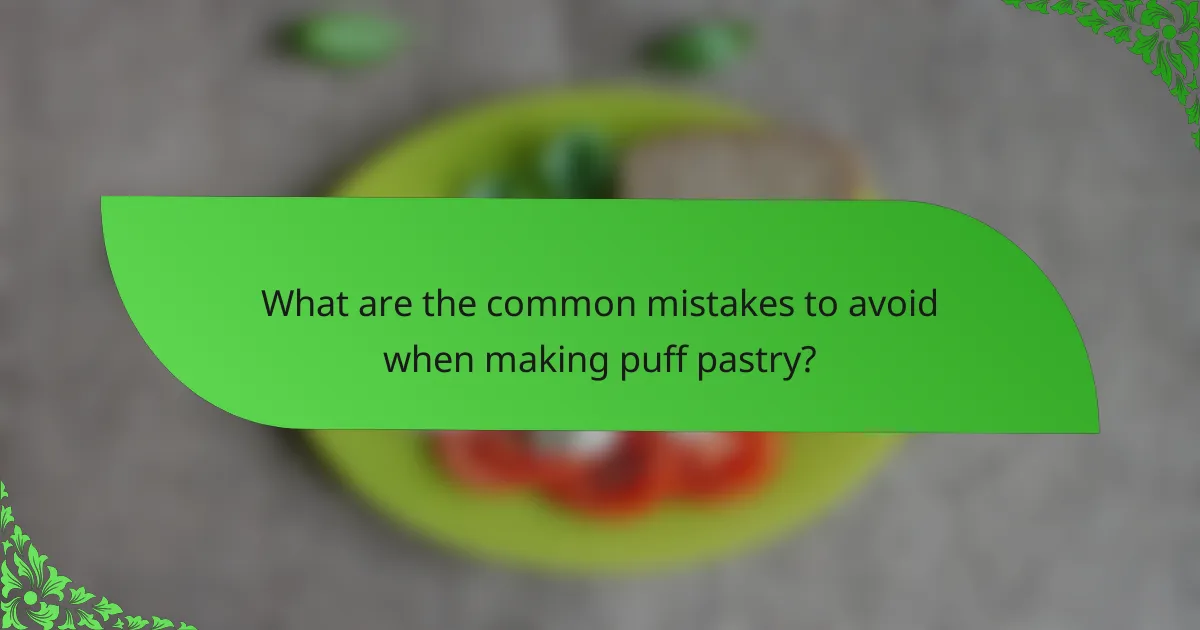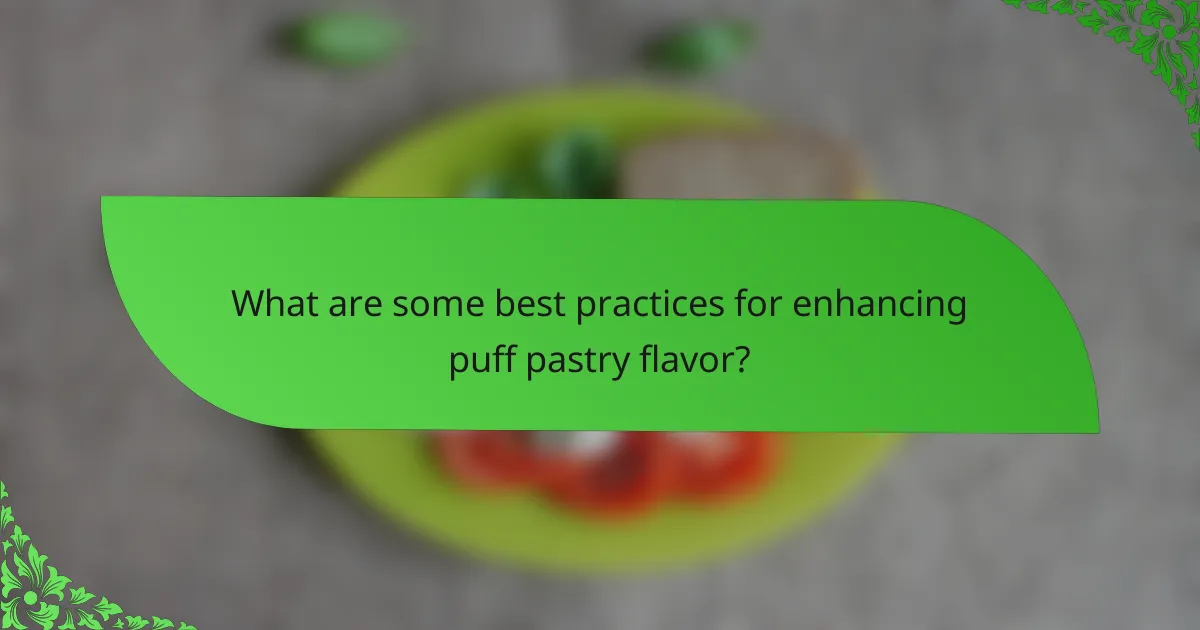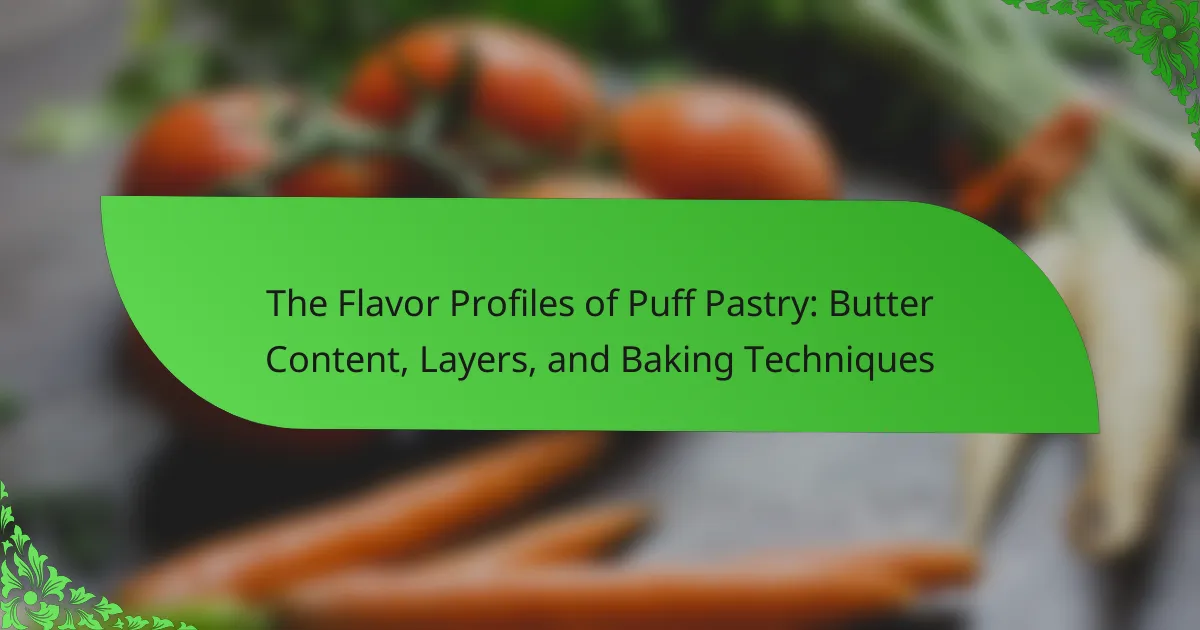Puff pastry is a versatile pastry known for its rich, buttery flavor and flaky texture, achieved through a high butter content and a meticulous layering process. The baking techniques used result in a golden-brown crust that enhances the overall flavor profile. Common mistakes in making puff pastry include overworking the dough, using warm ingredients, and failing to chill the dough, all of which can compromise the desired lightness and flakiness. To elevate the flavor, high-quality unsalted butter and flavorful fillings can be incorporated, while proper baking temperature and techniques are essential for achieving the perfect puff.

What are the flavor profiles of puff pastry?
Puff pastry has a rich, buttery flavor profile. The high butter content contributes to its distinct taste. This pastry is known for its flaky texture, which enhances its flavor experience. The layers formed during the preparation process create a light and airy mouthfeel. When baked, puff pastry develops a golden-brown crust that adds a slight nuttiness. Additionally, it can absorb flavors from fillings, making it versatile in both sweet and savory dishes. Overall, the combination of butter, layers, and baking techniques results in a complex flavor profile that is both indulgent and refined.
How does butter content influence the flavor of puff pastry?
Butter content significantly influences the flavor of puff pastry. Higher butter content enhances richness and depth of flavor. It contributes to a nutty taste when browned during baking. The fat from butter also adds a creamy mouthfeel. Additionally, butter helps create distinct layers, which affect texture and taste. A minimum of 20% butter to flour ratio is common for optimal flavor. This ratio allows for a balance of flakiness and taste. Studies show that pastries made with more butter have a more complex flavor profile.
What role does the type of butter play in flavor development?
The type of butter significantly influences flavor development in puff pastry. Different butters, such as unsalted, salted, and cultured, impart distinct flavor profiles. Unsalted butter allows for precise control over seasoning, enhancing the overall taste. Salted butter adds a savory element that can enhance the pastry’s richness. Cultured butter offers a tangy flavor due to the fermentation process, contributing complexity. The milk fat content also varies among butter types, affecting the mouthfeel and richness. Higher fat content typically leads to a flakier texture and deeper flavor. The specific choice of butter can elevate the final product, making it more appealing and flavorful.
How does the amount of butter affect the taste and texture?
The amount of butter significantly affects the taste and texture of puff pastry. Increased butter content enhances richness and flavor. It contributes to a flaky texture by creating steam during baking. More butter leads to a softer, more tender pastry. Conversely, less butter results in a drier texture and less pronounced flavor. A balance is essential for optimal results. Studies show that traditional puff pastry contains around 50% butter relative to flour for the best texture. This ratio promotes the ideal layering and flakiness characteristic of high-quality puff pastry.
What is the significance of layers in puff pastry flavor?
Layers in puff pastry significantly enhance its flavor and texture. Each layer contributes to a unique combination of buttery richness and flaky lightness. The process of lamination creates air pockets, which expand during baking. This expansion results in a delicate, crispy exterior. The layers also allow for better absorption of flavors from fillings. Ingredients within layers can meld, creating a more complex taste profile. Additionally, the Maillard reaction occurs between layers, contributing to a golden-brown color and enhanced flavor. Thus, the significance of layers is pivotal in achieving the desired sensory experience in puff pastry.
How do the layers contribute to the overall flavor experience?
The layers in puff pastry significantly enhance the overall flavor experience. Each layer contains butter, which adds richness and depth to the taste. As the pastry bakes, steam is generated between the layers. This steam causes the layers to separate and rise, creating a light, flaky texture. The flakiness allows for more surface area, which can absorb flavors during baking. Additionally, the Maillard reaction occurs on the outer layers, producing complex flavors due to browning. The combination of buttery richness and the crispy texture from the layers contributes to a satisfying mouthfeel. This multi-dimensional flavor experience is what makes puff pastry unique and enjoyable.
What techniques are used to create distinct layers in puff pastry?
The techniques used to create distinct layers in puff pastry include lamination and folding. Lamination involves encasing a block of butter in dough and rolling it out multiple times. Each roll creates layers of dough and butter. Folding the dough after each roll further increases the number of layers. Typically, this process is repeated in a series of turns, often referred to as “single turns” or “double turns.” A standard puff pastry recipe may involve around six to eight turns. This technique results in a flaky and airy texture when baked. The high water content in the butter also contributes to steam formation, which helps separate the layers during baking.
How do baking techniques impact the flavor of puff pastry?
Baking techniques significantly impact the flavor of puff pastry. The method of baking affects moisture retention and texture. High-temperature baking creates steam, contributing to flakiness. Flakiness enhances the buttery flavor profile. Additionally, techniques like blind baking can caramelize the pastry’s surface. This caramelization adds depth to the overall taste. The duration of baking also influences browning, which can intensify flavors. Properly executed techniques lead to a more complex flavor experience in puff pastry.
What baking temperatures and times are optimal for flavor?
Optimal baking temperatures for flavor in puff pastry are typically between 375°F and 425°F. Baking at these temperatures allows for proper browning and flavor development. The ideal baking time ranges from 20 to 30 minutes, depending on the thickness of the pastry. At 375°F, a longer baking time may be required to achieve the desired crispness. Conversely, higher temperatures like 425°F yield quicker cooking with a more pronounced flavor due to the Maillard reaction. This reaction occurs when sugars and proteins in the pastry interact under heat, enhancing the overall taste. Properly managing these temperatures and times ensures a flaky texture and rich flavor profile in the final product.
How does the method of baking (e.g., convection vs. traditional) affect flavor?
Baking methods significantly influence flavor in puff pastry. Convection baking circulates hot air, promoting even cooking and browning. This results in a crispier texture and enhanced flavor development. Traditional baking relies on radiant heat, which can lead to uneven baking. The lack of air circulation may cause some areas to bake slower, affecting flavor consistency. Studies show that convection baking can improve Maillard reaction rates, enhancing savory flavors. In contrast, traditional methods may produce a more pronounced buttery taste due to slower heat absorption.
What are the key components that define puff pastry flavor?
The key components that define puff pastry flavor include butter content, layers, and baking techniques. Butter contributes richness and a distinct flavor. The quality of butter affects the overall taste profile. Layers create texture and enhance flavor through steam release during baking. The baking process caramelizes sugars, adding depth to the flavor. Additionally, the use of salt balances sweetness and enhances the overall taste. Each of these components plays a crucial role in the final flavor experience of puff pastry.
How do regional variations influence puff pastry flavors?
Regional variations significantly influence puff pastry flavors through the use of local ingredients and traditional techniques. Different regions incorporate unique fats, such as lard in some cultures or different types of butter in others. These fats impact the overall taste and texture of the pastry. Additionally, local flavorings and spices are often added, reflecting regional culinary preferences. For instance, French puff pastry may emphasize rich butter flavors, while Eastern European versions might include sour cream for tanginess. Historical culinary practices also play a role, as certain regions have developed specific methods for layering and baking. These practices can enhance flavor complexity and aroma. Overall, regional ingredients and techniques create distinctive flavor profiles in puff pastry.

What are the common mistakes to avoid when making puff pastry?
Common mistakes to avoid when making puff pastry include overworking the dough. Overworking can lead to tough pastry instead of flaky layers. Another mistake is using warm ingredients. Warm butter or dough can prevent proper lamination. Failing to chill the dough between folds is also critical. Chilling allows the butter to solidify, creating distinct layers. Not rolling out the dough evenly can result in uneven baking. Uneven thickness affects how the pastry rises. Lastly, neglecting to preheat the oven can hinder proper puffing. A hot oven is essential for achieving the desired texture.
How can improper butter handling affect puff pastry flavor?
Improper butter handling can negatively impact puff pastry flavor. When butter is not kept cold, it can become too soft. This results in less distinct layers during baking. The pastry may then develop a greasy texture. A greasy texture can overshadow the buttery flavor. Additionally, if butter is overworked, it can lose its ability to create steam. Steam is crucial for puffing the layers. Without proper puffing, the final product lacks the desired flaky texture. A flaky texture is essential for a rich flavor experience in puff pastry.
What are the signs of overworking the dough?
Signs of overworking the dough include a tough texture and a shiny surface. The dough may also lose elasticity and become difficult to roll out. Additionally, it can develop a dry appearance and may crack when stretched. Overworked dough often results in a less flaky pastry after baking. This occurs because gluten becomes overly developed, leading to a dense final product. The ideal dough should be smooth and slightly tacky, not overly stiff or dry.
How does temperature impact the butter’s effectiveness in puff pastry?
Temperature significantly impacts butter’s effectiveness in puff pastry. Cold butter creates distinct layers by preventing the fat from fully incorporating into the dough. This separation is crucial for achieving the desired flakiness. When butter is too warm, it becomes greasy and mixes too thoroughly with the flour. This results in a denser pastry with fewer layers. The ideal temperature for butter in puff pastry is around 32°F (0°C). At this temperature, the butter is firm yet pliable. It can be easily rolled into the dough without melting. This maintains the integrity of the layers during the lamination process. The consistent temperature also ensures even baking, enhancing the overall texture.
What baking techniques should be avoided for optimal flavor?
Overmixing dough should be avoided for optimal flavor in baking. Overmixing can develop gluten excessively, leading to a tough texture. This toughness detracts from the lightness desired in puff pastry. Additionally, baking at too low a temperature can prevent proper puffing and browning. Insufficient heat results in a lack of flavor development through caramelization. Using stale ingredients also negatively impacts flavor. Fresh ingredients are crucial for achieving the best taste. Lastly, neglecting to properly layer the dough can lead to uneven cooking and flavor distribution. Proper layering enhances both texture and taste.
How can incorrect baking times ruin the flavor profile?
Incorrect baking times can significantly alter the flavor profile of puff pastry. Overbaking can lead to a dry texture, which diminishes the richness of the butter. This dryness can mask the delicate flavors intended in the pastry. Additionally, burnt edges develop when baking time exceeds the required duration. These burnt areas introduce bitter notes that overpower the intended sweetness. Underbaking can also negatively affect flavor. Insufficient baking results in a doughy texture, preventing the full development of flavors. The Maillard reaction, crucial for flavor enhancement, occurs best at optimal baking times. Therefore, precise baking times are essential for achieving the desired flavor profile in puff pastry.
What are the consequences of not preheating the oven?
Not preheating the oven can lead to uneven cooking and poor texture in baked goods. Puff pastry relies on a hot oven to create steam, which helps it rise. Without preheating, the pastry may not puff up properly. This can result in a dense and soggy texture instead of a light and flaky one. Additionally, the cooking time may increase, causing the outer layers to overcook while the inside remains undercooked. The lack of initial heat can also affect the browning and flavor development. Therefore, preheating is crucial for achieving optimal results in baking.

What are some best practices for enhancing puff pastry flavor?
Incorporating high-quality butter significantly enhances puff pastry flavor. The fat content in butter contributes to a rich taste and flaky texture. Using unsalted butter allows for better control over seasoning. Adding herbs or spices to the butter can infuse additional flavors. Chilling the dough properly before baking helps maintain flavor integrity. Utilizing a flavorful filling, such as cheese or vegetables, complements the pastry. Brushing the pastry with an egg wash before baking adds a golden color and enhances flavor. Finally, baking at a high temperature ensures proper puffing and browning, which intensifies the overall flavor.
How can additional ingredients enhance the flavor of puff pastry?
Additional ingredients can significantly enhance the flavor of puff pastry. Ingredients like herbs, spices, and cheeses introduce new taste dimensions. For example, adding fresh herbs like thyme or rosemary infuses aromatic qualities. Incorporating spices such as paprika or nutmeg can add warmth and complexity. Cheese, like Gruyère or feta, contributes a savory depth. Sweet additions, like sugar or vanilla, can create a dessert-like profile. Each ingredient interacts with the buttery layers, elevating the overall flavor experience. The combination of these elements can transform a simple pastry into a gourmet treat.
What flavor enhancers can be added to the dough?
Common flavor enhancers that can be added to dough include salt, sugar, herbs, spices, and extracts. Salt enhances overall flavor and balances sweetness. Sugar adds sweetness and promotes browning during baking. Herbs like thyme or rosemary impart aromatic qualities. Spices such as cinnamon or nutmeg can provide warmth and depth. Extracts like vanilla or almond contribute unique flavors. Each of these enhancers can significantly alter the taste profile of the final pastry.
How do fillings affect the overall flavor profile?
Fillings significantly influence the overall flavor profile of puff pastry. They introduce distinct flavors that can enhance or contrast with the buttery taste of the pastry. For instance, sweet fillings like fruit or chocolate add sweetness, while savory fillings such as cheese or vegetables provide umami. The combination of these flavors creates a more complex taste experience. Additionally, the spices and herbs used in fillings can further elevate the flavor profile. Studies show that flavor interactions between the pastry and fillings can create a harmonious balance, enhancing the overall enjoyment of the dish.
What tips can help achieve the best flavor in puff pastry?
Use high-quality butter for rich flavor in puff pastry. The butter should be cold and unsalted. This ensures distinct layers and a flaky texture. Incorporate the butter into the dough using the fraisage technique. This technique helps distribute the butter evenly. Chill the dough between folds to maintain its temperature. This prevents the butter from melting into the dough. Add a pinch of salt to enhance the overall flavor. Use a light hand when mixing to avoid overworking the dough. This preserves the delicate texture essential for puff pastry.
How does resting the dough improve flavor development?
Resting the dough improves flavor development by allowing enzymatic reactions to occur. During rest, enzymes break down starches into sugars. This process enhances the dough’s sweetness and complexity. Additionally, resting allows gluten to relax. Relaxed gluten makes the dough easier to shape and contributes to a better texture. Flavor compounds also have time to meld and deepen during resting. Research indicates that longer resting periods can lead to more pronounced flavors. For example, a study published in the Journal of Culinary Science & Technology shows that dough rested for 24 hours had significantly improved flavor compared to freshly mixed dough.
What are the benefits of using high-quality ingredients?
Using high-quality ingredients enhances flavor, texture, and overall dish quality. High-quality ingredients often contain more nutrients and fewer additives. For instance, premium butter provides a richer taste and better flakiness in puff pastry. Additionally, fresh produce contributes to vibrant flavors and essential vitamins. Research shows that using high-quality flour improves dough elasticity and structure. Consequently, dishes made with superior ingredients tend to be more satisfying and flavorful. This is supported by culinary experts who emphasize the importance of ingredient quality in achieving exceptional results.
The main entity of this article is puff pastry, which is characterized by its rich, buttery flavor profile and flaky texture. The article explores how butter content, the significance of layers, and various baking techniques contribute to the overall flavor experience of puff pastry. It discusses the impact of different types of butter, the importance of proper lamination, and the optimal baking temperatures and times for flavor development. Additionally, it addresses common mistakes to avoid when making puff pastry and offers best practices for enhancing its flavor through quality ingredients and fillings.
